Strategic Approaches to Competitive Advantage in Retail
VerifiedAdded on 2020/04/29
|25
|6104
|143
AI Summary
The retail landscape is highly dynamic, requiring companies to adopt innovative strategies to sustain their competitive advantage. This essay examines key approaches such as product diversification, which allows retailers to cater to varied consumer needs and mitigate risks associated with market fluctuations. Additionally, it explores how adopting a strong market orientation can enable firms to respond proactively to customer demands and changes in the market environment. The strategic use of SWOT analysis is also discussed as a critical tool for identifying internal strengths and weaknesses, alongside external opportunities and threats. By integrating these strategies, retailers can enhance their adaptability and resilience, ensuring long-term growth and profitability in an ever-evolving marketplace.
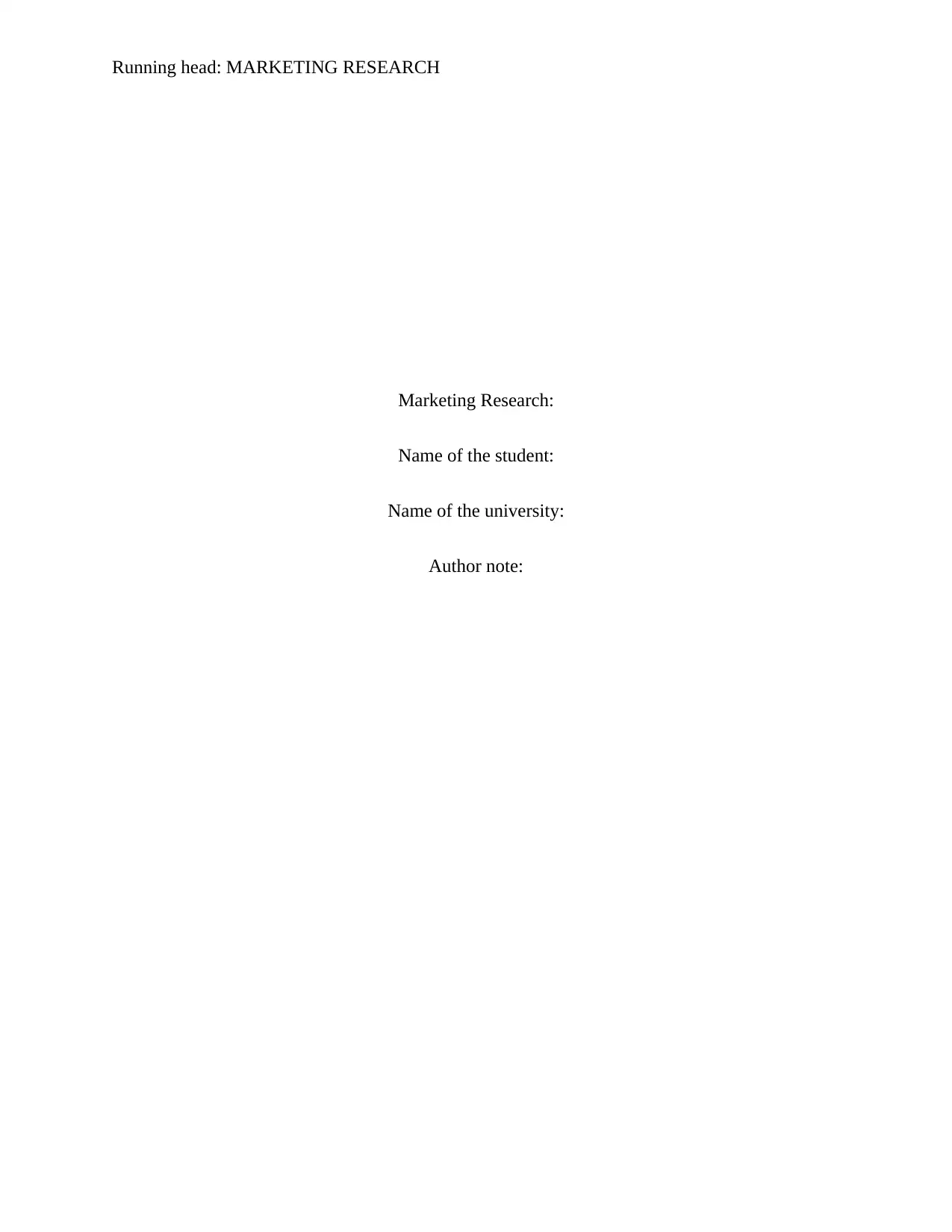
Running head: MARKETING RESEARCH
Marketing Research:
Name of the student:
Name of the university:
Author note:
Marketing Research:
Name of the student:
Name of the university:
Author note:
Paraphrase This Document
Need a fresh take? Get an instant paraphrase of this document with our AI Paraphraser

1
MARKETING RESEARCH
Executive Summary
This is a study, which will compare the marketing mix of two retail companies in United Arab
Emirates. The two rival companies that have chosen for the study are Landmark and Emke.
These two companies are the fastest growing companies in United Arab Emirates and have been
included in the top 50 fastest growing global retail organizations. Emke group, which consist of
Lulu Hypermarkets, are the 9th fastest growing retail chain in the United Kingdom and Landmark
is the 16th fastest growing retail chain in the world. Even though the growth rate of Emke group
is more than Landmark, the market share and revenue generation of Emke in these sectors is less
than Landmark. Landmark is ranked at 198th position among the top 250 retail companies in the
world and Lulu hypermarkets is ranked 213th among the top 250 retail companies in the world.
Thus, by linking with the objective of the study it can be highlighted that marketing mix of both
the organizations are similar in nature as they operate in the same market. Moreover, as their
macro environment factors are same, they are using similar strategies to mitigate their market
risk. However, they have a lot of opportunity of improving their scope in the market by using
innovative marketing strategies for increasing their penetration in the market.
MARKETING RESEARCH
Executive Summary
This is a study, which will compare the marketing mix of two retail companies in United Arab
Emirates. The two rival companies that have chosen for the study are Landmark and Emke.
These two companies are the fastest growing companies in United Arab Emirates and have been
included in the top 50 fastest growing global retail organizations. Emke group, which consist of
Lulu Hypermarkets, are the 9th fastest growing retail chain in the United Kingdom and Landmark
is the 16th fastest growing retail chain in the world. Even though the growth rate of Emke group
is more than Landmark, the market share and revenue generation of Emke in these sectors is less
than Landmark. Landmark is ranked at 198th position among the top 250 retail companies in the
world and Lulu hypermarkets is ranked 213th among the top 250 retail companies in the world.
Thus, by linking with the objective of the study it can be highlighted that marketing mix of both
the organizations are similar in nature as they operate in the same market. Moreover, as their
macro environment factors are same, they are using similar strategies to mitigate their market
risk. However, they have a lot of opportunity of improving their scope in the market by using
innovative marketing strategies for increasing their penetration in the market.
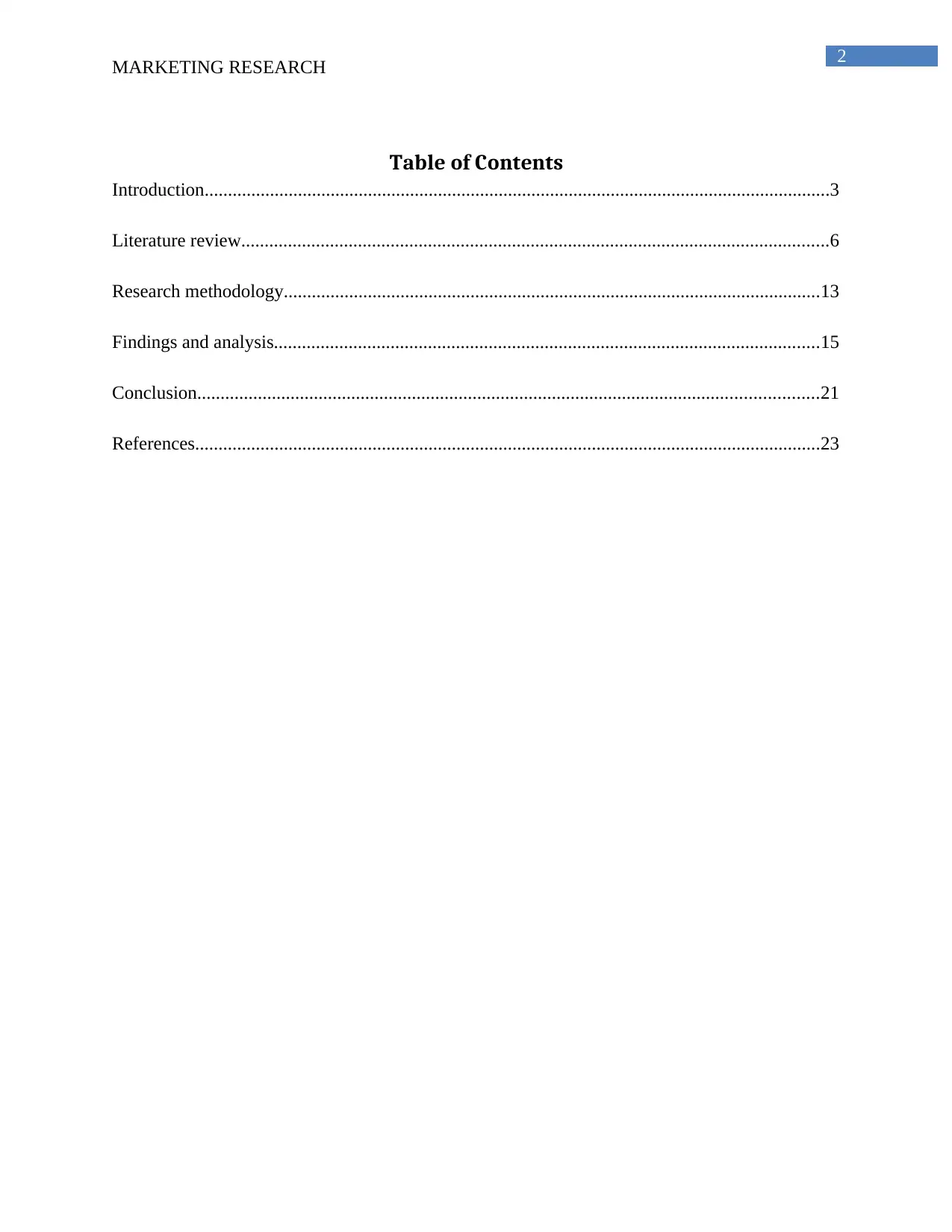
2
MARKETING RESEARCH
Table of Contents
Introduction......................................................................................................................................3
Literature review..............................................................................................................................6
Research methodology...................................................................................................................13
Findings and analysis.....................................................................................................................15
Conclusion.....................................................................................................................................21
References......................................................................................................................................23
MARKETING RESEARCH
Table of Contents
Introduction......................................................................................................................................3
Literature review..............................................................................................................................6
Research methodology...................................................................................................................13
Findings and analysis.....................................................................................................................15
Conclusion.....................................................................................................................................21
References......................................................................................................................................23
⊘ This is a preview!⊘
Do you want full access?
Subscribe today to unlock all pages.

Trusted by 1+ million students worldwide
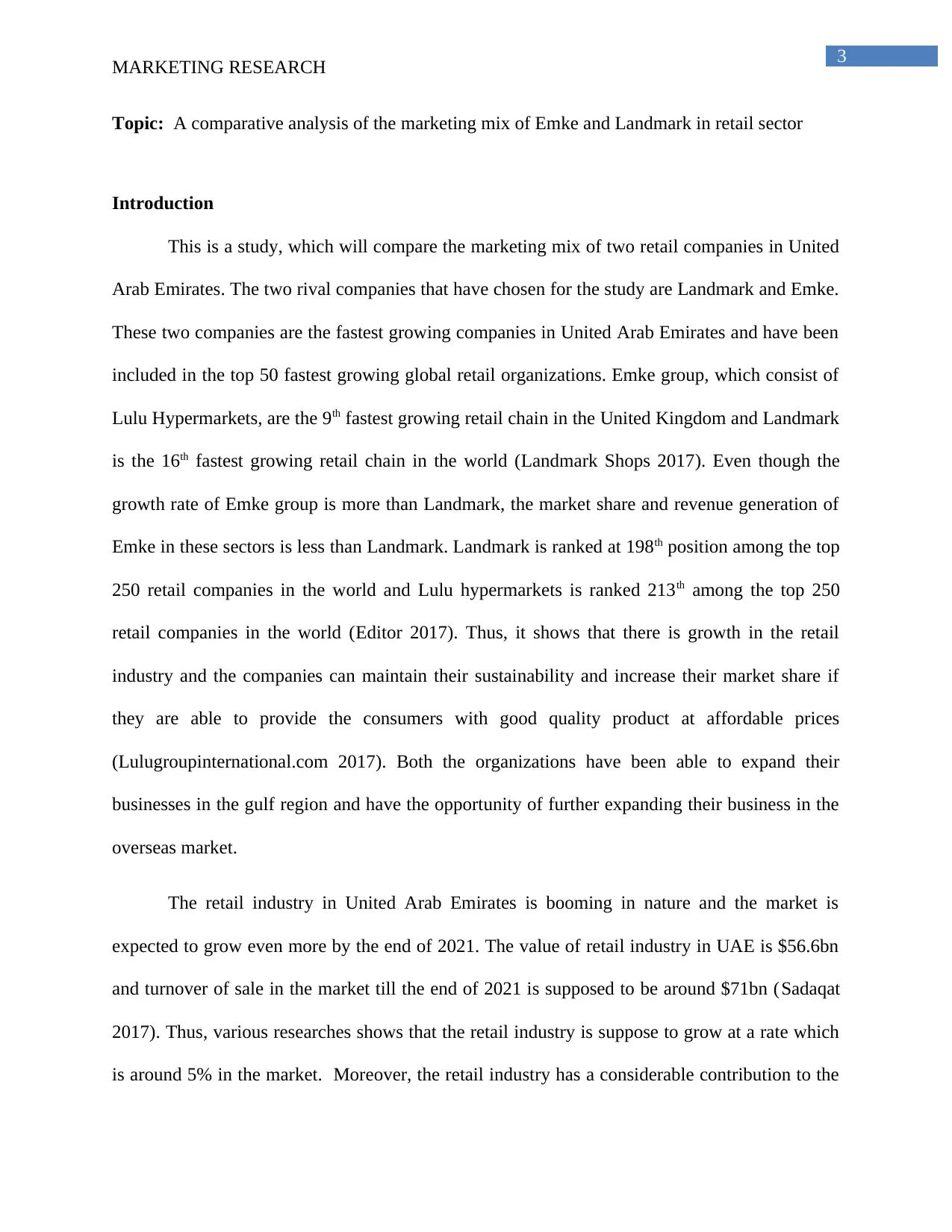
3
MARKETING RESEARCH
Topic: A comparative analysis of the marketing mix of Emke and Landmark in retail sector
Introduction
This is a study, which will compare the marketing mix of two retail companies in United
Arab Emirates. The two rival companies that have chosen for the study are Landmark and Emke.
These two companies are the fastest growing companies in United Arab Emirates and have been
included in the top 50 fastest growing global retail organizations. Emke group, which consist of
Lulu Hypermarkets, are the 9th fastest growing retail chain in the United Kingdom and Landmark
is the 16th fastest growing retail chain in the world (Landmark Shops 2017). Even though the
growth rate of Emke group is more than Landmark, the market share and revenue generation of
Emke in these sectors is less than Landmark. Landmark is ranked at 198th position among the top
250 retail companies in the world and Lulu hypermarkets is ranked 213th among the top 250
retail companies in the world (Editor 2017). Thus, it shows that there is growth in the retail
industry and the companies can maintain their sustainability and increase their market share if
they are able to provide the consumers with good quality product at affordable prices
(Lulugroupinternational.com 2017). Both the organizations have been able to expand their
businesses in the gulf region and have the opportunity of further expanding their business in the
overseas market.
The retail industry in United Arab Emirates is booming in nature and the market is
expected to grow even more by the end of 2021. The value of retail industry in UAE is $56.6bn
and turnover of sale in the market till the end of 2021 is supposed to be around $71bn (Sadaqat
2017). Thus, various researches shows that the retail industry is suppose to grow at a rate which
is around 5% in the market. Moreover, the retail industry has a considerable contribution to the
MARKETING RESEARCH
Topic: A comparative analysis of the marketing mix of Emke and Landmark in retail sector
Introduction
This is a study, which will compare the marketing mix of two retail companies in United
Arab Emirates. The two rival companies that have chosen for the study are Landmark and Emke.
These two companies are the fastest growing companies in United Arab Emirates and have been
included in the top 50 fastest growing global retail organizations. Emke group, which consist of
Lulu Hypermarkets, are the 9th fastest growing retail chain in the United Kingdom and Landmark
is the 16th fastest growing retail chain in the world (Landmark Shops 2017). Even though the
growth rate of Emke group is more than Landmark, the market share and revenue generation of
Emke in these sectors is less than Landmark. Landmark is ranked at 198th position among the top
250 retail companies in the world and Lulu hypermarkets is ranked 213th among the top 250
retail companies in the world (Editor 2017). Thus, it shows that there is growth in the retail
industry and the companies can maintain their sustainability and increase their market share if
they are able to provide the consumers with good quality product at affordable prices
(Lulugroupinternational.com 2017). Both the organizations have been able to expand their
businesses in the gulf region and have the opportunity of further expanding their business in the
overseas market.
The retail industry in United Arab Emirates is booming in nature and the market is
expected to grow even more by the end of 2021. The value of retail industry in UAE is $56.6bn
and turnover of sale in the market till the end of 2021 is supposed to be around $71bn (Sadaqat
2017). Thus, various researches shows that the retail industry is suppose to grow at a rate which
is around 5% in the market. Moreover, the retail industry has a considerable contribution to the
Paraphrase This Document
Need a fresh take? Get an instant paraphrase of this document with our AI Paraphraser

4
MARKETING RESEARCH
economy of country and the retail industry contributes 11% to the GDP (Frank 2017). The
demand in the retail sector in the UAE remained stable in the fiscal year of 2016 and increase in
the footfall in this sector increased by 6% (AMEInfo 2017). The rise in the number of tourists in
the country has supported the growth of the industry due to the lack of sales tax and expansion in
promotion and sales events. Thus, this shows that there has been a steady increase in the volume
of sales and the number of consumers in the retail industry. The infrastructure in this industry is
expanding at a rapid rate, which shows that the companies are positive about the growth in the
market.
Competitor analysis is used to position the organizations strengths against the weakness
of the competitors in the market or the organization chooses position which poses no potential
thereat for the organization. This means that it is essential for the organization to be aware of the
strengths and weaknesses of its competitors as much as they are aware of the needs and desires
of the consumers in the market (He et al. 2015). The main objective of the competitor analysis is
to identify the strengths and weaknesses of the organization so that they can predict their next
move. The competitive strategies are developed based on the analysis of the competitors in the
market. This enables them to take counter measures for gaining competitive advantage and
maintain their long-term sustainability in the market. Thus, the organization should have a better
understanding of the market conditions so that they can analyze the actions that the competitors
can take. The main objectives of the competitor analysis for any organization are as follows:
Calculate the potential strategies available to the consumers that could provide them with
success in the market
Predicting the counter measures which the rival company can take
MARKETING RESEARCH
economy of country and the retail industry contributes 11% to the GDP (Frank 2017). The
demand in the retail sector in the UAE remained stable in the fiscal year of 2016 and increase in
the footfall in this sector increased by 6% (AMEInfo 2017). The rise in the number of tourists in
the country has supported the growth of the industry due to the lack of sales tax and expansion in
promotion and sales events. Thus, this shows that there has been a steady increase in the volume
of sales and the number of consumers in the retail industry. The infrastructure in this industry is
expanding at a rapid rate, which shows that the companies are positive about the growth in the
market.
Competitor analysis is used to position the organizations strengths against the weakness
of the competitors in the market or the organization chooses position which poses no potential
thereat for the organization. This means that it is essential for the organization to be aware of the
strengths and weaknesses of its competitors as much as they are aware of the needs and desires
of the consumers in the market (He et al. 2015). The main objective of the competitor analysis is
to identify the strengths and weaknesses of the organization so that they can predict their next
move. The competitive strategies are developed based on the analysis of the competitors in the
market. This enables them to take counter measures for gaining competitive advantage and
maintain their long-term sustainability in the market. Thus, the organization should have a better
understanding of the market conditions so that they can analyze the actions that the competitors
can take. The main objectives of the competitor analysis for any organization are as follows:
Calculate the potential strategies available to the consumers that could provide them with
success in the market
Predicting the counter measures which the rival company can take
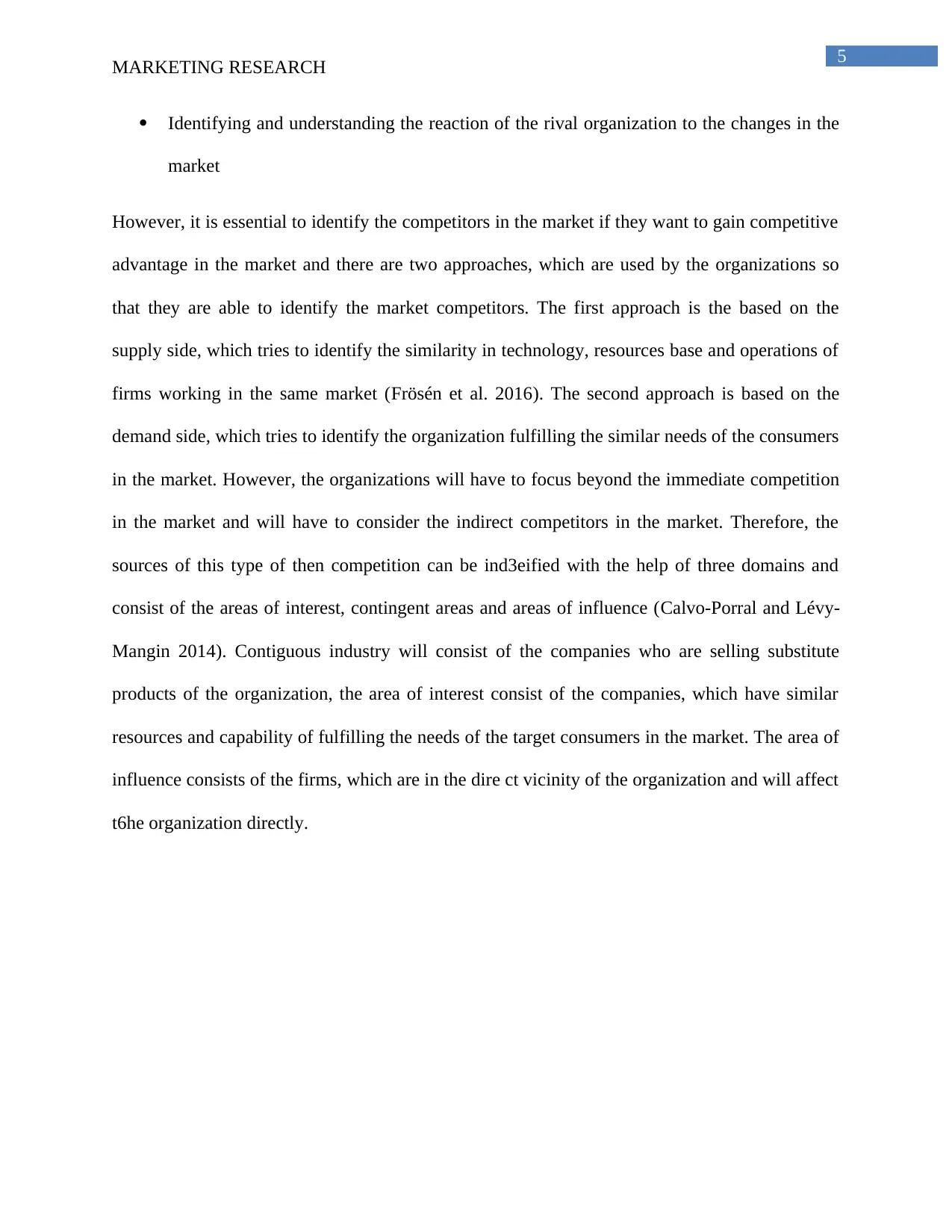
5
MARKETING RESEARCH
Identifying and understanding the reaction of the rival organization to the changes in the
market
However, it is essential to identify the competitors in the market if they want to gain competitive
advantage in the market and there are two approaches, which are used by the organizations so
that they are able to identify the market competitors. The first approach is the based on the
supply side, which tries to identify the similarity in technology, resources base and operations of
firms working in the same market (Frösén et al. 2016). The second approach is based on the
demand side, which tries to identify the organization fulfilling the similar needs of the consumers
in the market. However, the organizations will have to focus beyond the immediate competition
in the market and will have to consider the indirect competitors in the market. Therefore, the
sources of this type of then competition can be ind3eified with the help of three domains and
consist of the areas of interest, contingent areas and areas of influence (Calvo-Porral and Lévy-
Mangin 2014). Contiguous industry will consist of the companies who are selling substitute
products of the organization, the area of interest consist of the companies, which have similar
resources and capability of fulfilling the needs of the target consumers in the market. The area of
influence consists of the firms, which are in the dire ct vicinity of the organization and will affect
t6he organization directly.
MARKETING RESEARCH
Identifying and understanding the reaction of the rival organization to the changes in the
market
However, it is essential to identify the competitors in the market if they want to gain competitive
advantage in the market and there are two approaches, which are used by the organizations so
that they are able to identify the market competitors. The first approach is the based on the
supply side, which tries to identify the similarity in technology, resources base and operations of
firms working in the same market (Frösén et al. 2016). The second approach is based on the
demand side, which tries to identify the organization fulfilling the similar needs of the consumers
in the market. However, the organizations will have to focus beyond the immediate competition
in the market and will have to consider the indirect competitors in the market. Therefore, the
sources of this type of then competition can be ind3eified with the help of three domains and
consist of the areas of interest, contingent areas and areas of influence (Calvo-Porral and Lévy-
Mangin 2014). Contiguous industry will consist of the companies who are selling substitute
products of the organization, the area of interest consist of the companies, which have similar
resources and capability of fulfilling the needs of the target consumers in the market. The area of
influence consists of the firms, which are in the dire ct vicinity of the organization and will affect
t6he organization directly.
⊘ This is a preview!⊘
Do you want full access?
Subscribe today to unlock all pages.

Trusted by 1+ million students worldwide

6
MARKETING RESEARCH
Literature review
The competitor analysis of the study will consist of situational analysis and the internal
analysis of both the organizations. However, the situational analysis will consist of both macro
and micro environmental analysis of the organizations, which consist of PESTLE and Porter’s
five forces. The internal environment analysis will consist of SWOT analysis and thus, amount
of factors that are included in the study are huge which make the analysis quite thin. Thus,
integrated model will be used which will consist of SWOT, Pestle and Porter’s five forces at the
same time (Yu, Ramanathan and Nath 2014). The study will attempt to link all the environments
together to provide a better result in the study. The macro, micro and the internal environmental
an analysis of the organization can be linked together as it is examining the positives and
negatives of the organization. However, the organization does not have any control on the
external environment of the organization and cannot avoid its impact. The microenvironment and
the internal environment can be controlled by organizations, which mean that the organizations
will have to put focus on the internal environment.
Pestle analysis is a framework, which is being used by the marketers for identifying the
macro factors in the market. The word PESTLE stands for Political, Economic, Social,
technological, Environmental and Legal factors of the organization.
MARKETING RESEARCH
Literature review
The competitor analysis of the study will consist of situational analysis and the internal
analysis of both the organizations. However, the situational analysis will consist of both macro
and micro environmental analysis of the organizations, which consist of PESTLE and Porter’s
five forces. The internal environment analysis will consist of SWOT analysis and thus, amount
of factors that are included in the study are huge which make the analysis quite thin. Thus,
integrated model will be used which will consist of SWOT, Pestle and Porter’s five forces at the
same time (Yu, Ramanathan and Nath 2014). The study will attempt to link all the environments
together to provide a better result in the study. The macro, micro and the internal environmental
an analysis of the organization can be linked together as it is examining the positives and
negatives of the organization. However, the organization does not have any control on the
external environment of the organization and cannot avoid its impact. The microenvironment and
the internal environment can be controlled by organizations, which mean that the organizations
will have to put focus on the internal environment.
Pestle analysis is a framework, which is being used by the marketers for identifying the
macro factors in the market. The word PESTLE stands for Political, Economic, Social,
technological, Environmental and Legal factors of the organization.
Paraphrase This Document
Need a fresh take? Get an instant paraphrase of this document with our AI Paraphraser
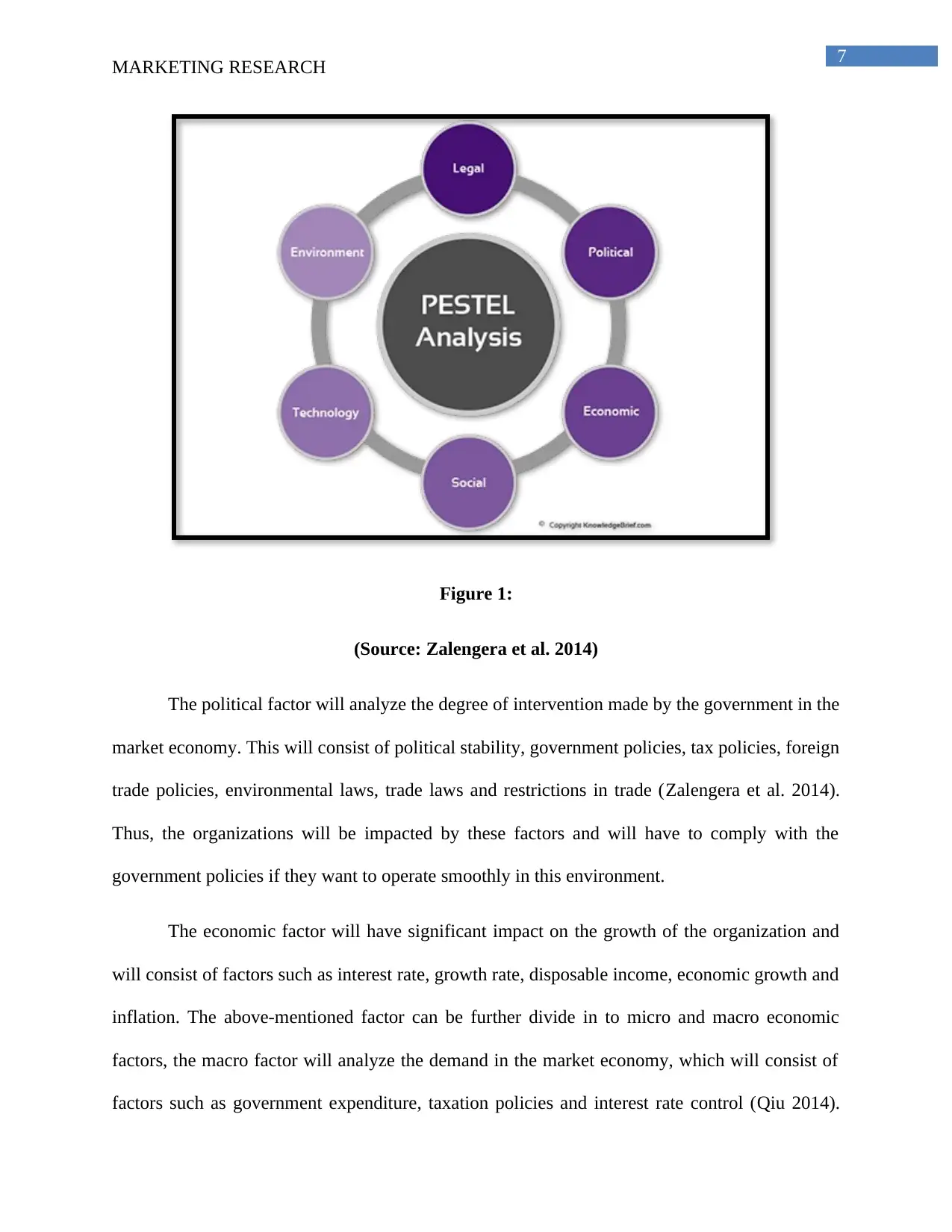
7
MARKETING RESEARCH
Figure 1:
(Source: Zalengera et al. 2014)
The political factor will analyze the degree of intervention made by the government in the
market economy. This will consist of political stability, government policies, tax policies, foreign
trade policies, environmental laws, trade laws and restrictions in trade (Zalengera et al. 2014).
Thus, the organizations will be impacted by these factors and will have to comply with the
government policies if they want to operate smoothly in this environment.
The economic factor will have significant impact on the growth of the organization and
will consist of factors such as interest rate, growth rate, disposable income, economic growth and
inflation. The above-mentioned factor can be further divide in to micro and macro economic
factors, the macro factor will analyze the demand in the market economy, which will consist of
factors such as government expenditure, taxation policies and interest rate control (Qiu 2014).
MARKETING RESEARCH
Figure 1:
(Source: Zalengera et al. 2014)
The political factor will analyze the degree of intervention made by the government in the
market economy. This will consist of political stability, government policies, tax policies, foreign
trade policies, environmental laws, trade laws and restrictions in trade (Zalengera et al. 2014).
Thus, the organizations will be impacted by these factors and will have to comply with the
government policies if they want to operate smoothly in this environment.
The economic factor will have significant impact on the growth of the organization and
will consist of factors such as interest rate, growth rate, disposable income, economic growth and
inflation. The above-mentioned factor can be further divide in to micro and macro economic
factors, the macro factor will analyze the demand in the market economy, which will consist of
factors such as government expenditure, taxation policies and interest rate control (Qiu 2014).
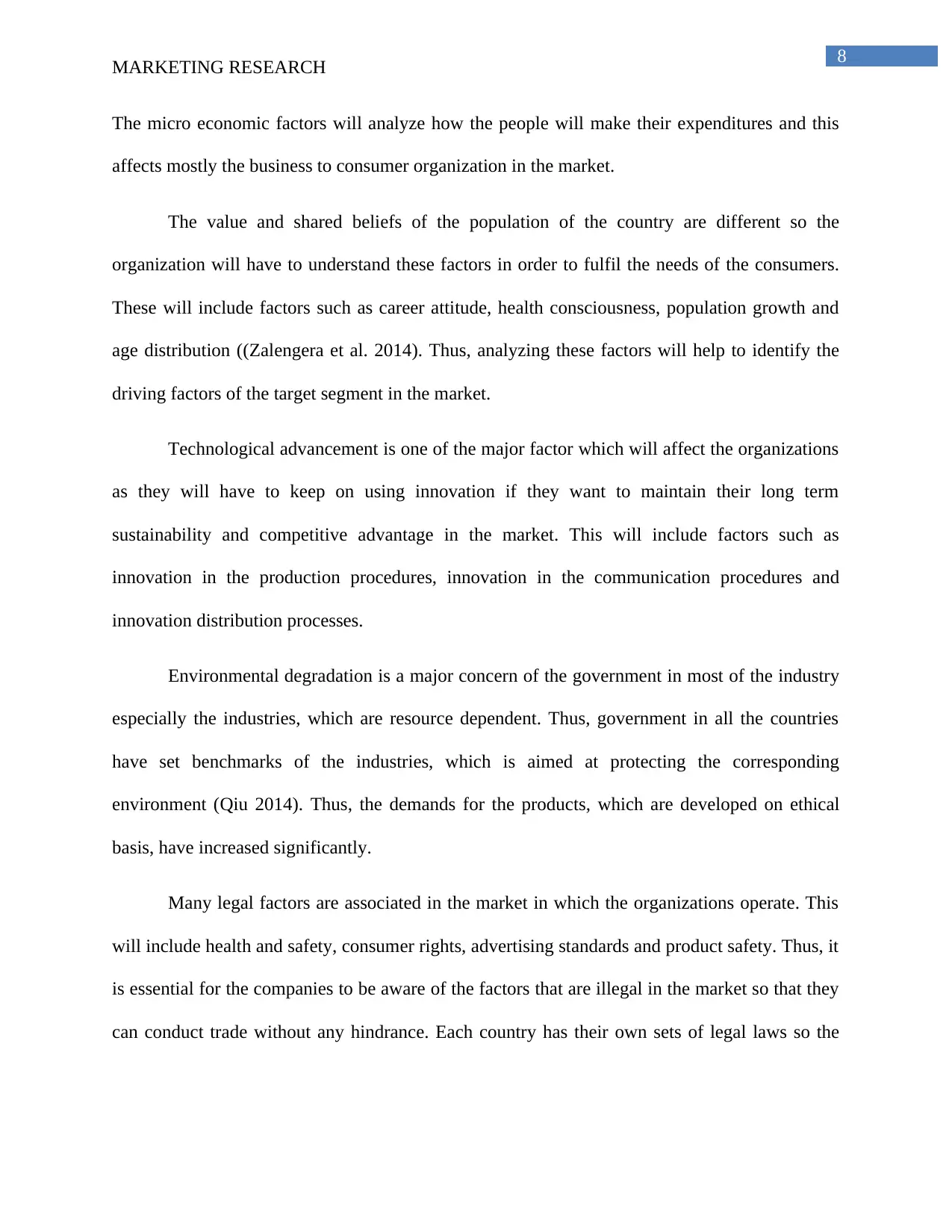
8
MARKETING RESEARCH
The micro economic factors will analyze how the people will make their expenditures and this
affects mostly the business to consumer organization in the market.
The value and shared beliefs of the population of the country are different so the
organization will have to understand these factors in order to fulfil the needs of the consumers.
These will include factors such as career attitude, health consciousness, population growth and
age distribution ((Zalengera et al. 2014). Thus, analyzing these factors will help to identify the
driving factors of the target segment in the market.
Technological advancement is one of the major factor which will affect the organizations
as they will have to keep on using innovation if they want to maintain their long term
sustainability and competitive advantage in the market. This will include factors such as
innovation in the production procedures, innovation in the communication procedures and
innovation distribution processes.
Environmental degradation is a major concern of the government in most of the industry
especially the industries, which are resource dependent. Thus, government in all the countries
have set benchmarks of the industries, which is aimed at protecting the corresponding
environment (Qiu 2014). Thus, the demands for the products, which are developed on ethical
basis, have increased significantly.
Many legal factors are associated in the market in which the organizations operate. This
will include health and safety, consumer rights, advertising standards and product safety. Thus, it
is essential for the companies to be aware of the factors that are illegal in the market so that they
can conduct trade without any hindrance. Each country has their own sets of legal laws so the
MARKETING RESEARCH
The micro economic factors will analyze how the people will make their expenditures and this
affects mostly the business to consumer organization in the market.
The value and shared beliefs of the population of the country are different so the
organization will have to understand these factors in order to fulfil the needs of the consumers.
These will include factors such as career attitude, health consciousness, population growth and
age distribution ((Zalengera et al. 2014). Thus, analyzing these factors will help to identify the
driving factors of the target segment in the market.
Technological advancement is one of the major factor which will affect the organizations
as they will have to keep on using innovation if they want to maintain their long term
sustainability and competitive advantage in the market. This will include factors such as
innovation in the production procedures, innovation in the communication procedures and
innovation distribution processes.
Environmental degradation is a major concern of the government in most of the industry
especially the industries, which are resource dependent. Thus, government in all the countries
have set benchmarks of the industries, which is aimed at protecting the corresponding
environment (Qiu 2014). Thus, the demands for the products, which are developed on ethical
basis, have increased significantly.
Many legal factors are associated in the market in which the organizations operate. This
will include health and safety, consumer rights, advertising standards and product safety. Thus, it
is essential for the companies to be aware of the factors that are illegal in the market so that they
can conduct trade without any hindrance. Each country has their own sets of legal laws so the
⊘ This is a preview!⊘
Do you want full access?
Subscribe today to unlock all pages.

Trusted by 1+ million students worldwide
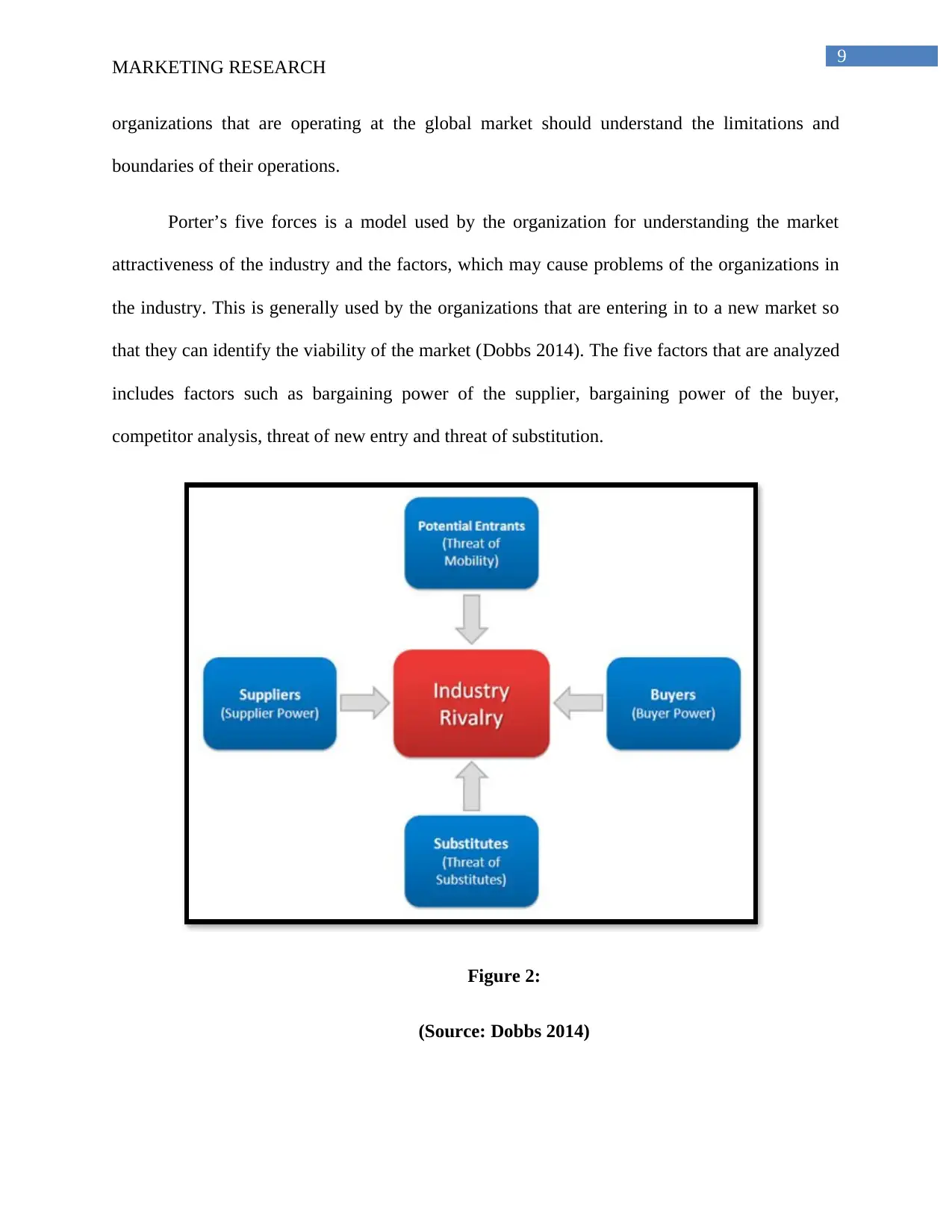
9
MARKETING RESEARCH
organizations that are operating at the global market should understand the limitations and
boundaries of their operations.
Porter’s five forces is a model used by the organization for understanding the market
attractiveness of the industry and the factors, which may cause problems of the organizations in
the industry. This is generally used by the organizations that are entering in to a new market so
that they can identify the viability of the market (Dobbs 2014). The five factors that are analyzed
includes factors such as bargaining power of the supplier, bargaining power of the buyer,
competitor analysis, threat of new entry and threat of substitution.
Figure 2:
(Source: Dobbs 2014)
MARKETING RESEARCH
organizations that are operating at the global market should understand the limitations and
boundaries of their operations.
Porter’s five forces is a model used by the organization for understanding the market
attractiveness of the industry and the factors, which may cause problems of the organizations in
the industry. This is generally used by the organizations that are entering in to a new market so
that they can identify the viability of the market (Dobbs 2014). The five factors that are analyzed
includes factors such as bargaining power of the supplier, bargaining power of the buyer,
competitor analysis, threat of new entry and threat of substitution.
Figure 2:
(Source: Dobbs 2014)
Paraphrase This Document
Need a fresh take? Get an instant paraphrase of this document with our AI Paraphraser

10
MARKETING RESEARCH
The bargaining power of the suppliers identifies the extent to which the supplier can
increase the prices, the uniqueness of the products offered, the number of suppliers in the
industry and switching cost of moving from one supplier to another. Competitor rivalry will
identify the strengths and weaknesses of the competitors in the market, the major competitors in
the market and the quality of the products they are offering to the consumers (Dälken 2014).
Thus, the organization can analyze their strengths and weaknesses with that of the rival
companies in the market. The bargaining power of the buyers will analyze the extent to which
the buyers can drive the prices in the industry, market size, volumes and switching cost of the
consumers (Rothaermel 2015). This will enable the organization to identify the needs and wants
of the consumers. The threat of substitution will identify the substitute products available in the
market. Thus, if the substitution of the product is easy for the consumers then it will pose a threat
to the organizations (Dälken 2014). The last factor is identification of threat from the new
entrants in the market and it will identify the entry barriers in the industry. Thus, if the entry
barriers in the market are low it will pose more threat to the organizations and if the entry
barriers in the market are low it will pose a threat to the companies in the market.
SWOT analysis identifies the internal strengths and weaknesses of the organization and
external opportunities and threats (Yan, Xia and Bao 2015). Thus, the framework is used for the
development of the strategies for identifying the deficiencies so that they can make continuous
improvement of the processes in the business model.
MARKETING RESEARCH
The bargaining power of the suppliers identifies the extent to which the supplier can
increase the prices, the uniqueness of the products offered, the number of suppliers in the
industry and switching cost of moving from one supplier to another. Competitor rivalry will
identify the strengths and weaknesses of the competitors in the market, the major competitors in
the market and the quality of the products they are offering to the consumers (Dälken 2014).
Thus, the organization can analyze their strengths and weaknesses with that of the rival
companies in the market. The bargaining power of the buyers will analyze the extent to which
the buyers can drive the prices in the industry, market size, volumes and switching cost of the
consumers (Rothaermel 2015). This will enable the organization to identify the needs and wants
of the consumers. The threat of substitution will identify the substitute products available in the
market. Thus, if the substitution of the product is easy for the consumers then it will pose a threat
to the organizations (Dälken 2014). The last factor is identification of threat from the new
entrants in the market and it will identify the entry barriers in the industry. Thus, if the entry
barriers in the market are low it will pose more threat to the organizations and if the entry
barriers in the market are low it will pose a threat to the companies in the market.
SWOT analysis identifies the internal strengths and weaknesses of the organization and
external opportunities and threats (Yan, Xia and Bao 2015). Thus, the framework is used for the
development of the strategies for identifying the deficiencies so that they can make continuous
improvement of the processes in the business model.
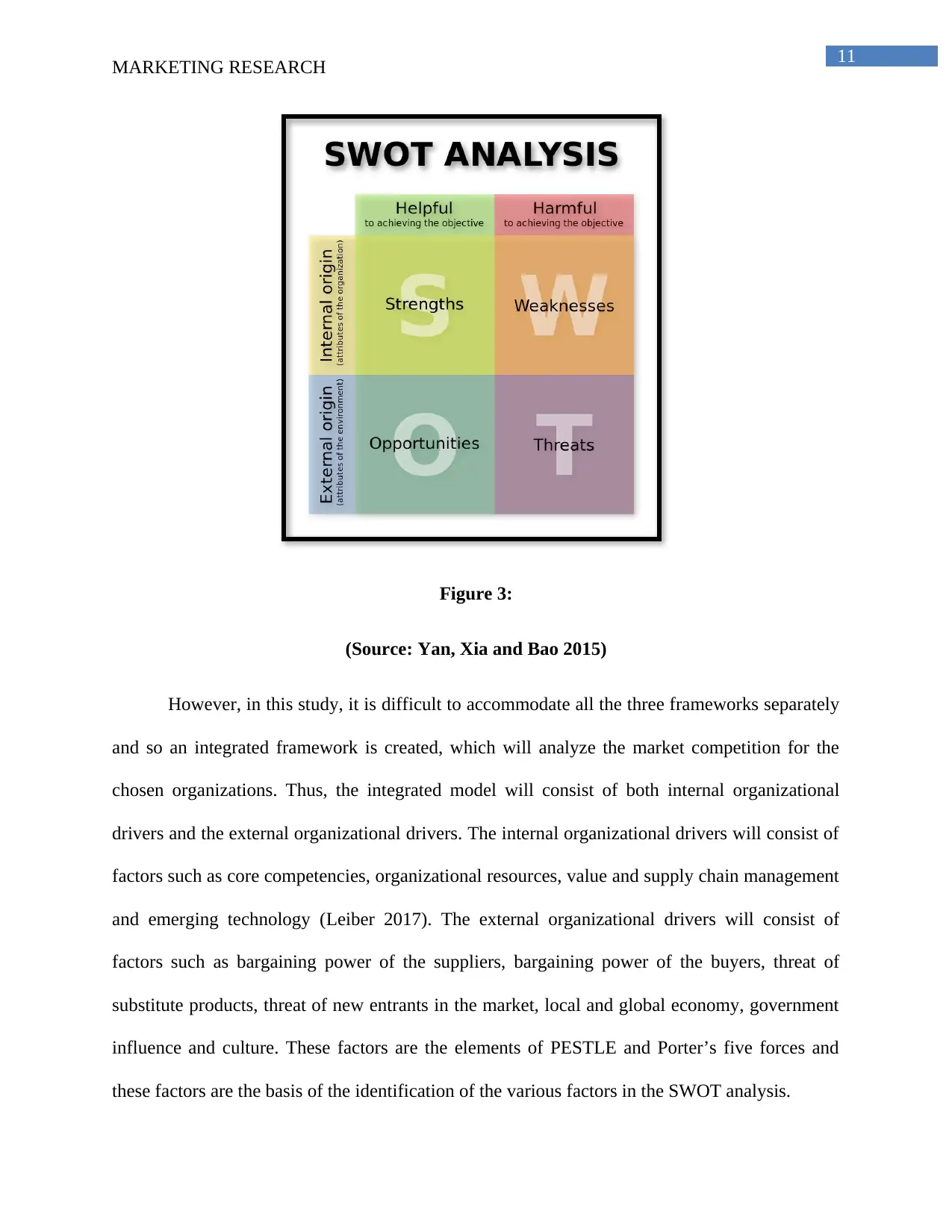
11
MARKETING RESEARCH
Figure 3:
(Source: Yan, Xia and Bao 2015)
However, in this study, it is difficult to accommodate all the three frameworks separately
and so an integrated framework is created, which will analyze the market competition for the
chosen organizations. Thus, the integrated model will consist of both internal organizational
drivers and the external organizational drivers. The internal organizational drivers will consist of
factors such as core competencies, organizational resources, value and supply chain management
and emerging technology (Leiber 2017). The external organizational drivers will consist of
factors such as bargaining power of the suppliers, bargaining power of the buyers, threat of
substitute products, threat of new entrants in the market, local and global economy, government
influence and culture. These factors are the elements of PESTLE and Porter’s five forces and
these factors are the basis of the identification of the various factors in the SWOT analysis.
MARKETING RESEARCH
Figure 3:
(Source: Yan, Xia and Bao 2015)
However, in this study, it is difficult to accommodate all the three frameworks separately
and so an integrated framework is created, which will analyze the market competition for the
chosen organizations. Thus, the integrated model will consist of both internal organizational
drivers and the external organizational drivers. The internal organizational drivers will consist of
factors such as core competencies, organizational resources, value and supply chain management
and emerging technology (Leiber 2017). The external organizational drivers will consist of
factors such as bargaining power of the suppliers, bargaining power of the buyers, threat of
substitute products, threat of new entrants in the market, local and global economy, government
influence and culture. These factors are the elements of PESTLE and Porter’s five forces and
these factors are the basis of the identification of the various factors in the SWOT analysis.
⊘ This is a preview!⊘
Do you want full access?
Subscribe today to unlock all pages.

Trusted by 1+ million students worldwide
1 out of 25
Related Documents
Your All-in-One AI-Powered Toolkit for Academic Success.
+13062052269
info@desklib.com
Available 24*7 on WhatsApp / Email
![[object Object]](/_next/static/media/star-bottom.7253800d.svg)
Unlock your academic potential
Copyright © 2020–2025 A2Z Services. All Rights Reserved. Developed and managed by ZUCOL.




